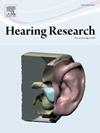A novel mouse model of acute vestibular dysfunction via semicircular canal injection of absolute ethanol
IF 2.5
2区 医学
Q1 AUDIOLOGY & SPEECH-LANGUAGE PATHOLOGY
引用次数: 0
Abstract
Objective
Various vestibular pathology models have been developed to elucidate the underlying mechanisms of vestibular diseases; however, there is a notable absence of minimally invasive mouse model of vestibular dysfunction. In this study, we established a novel model and conducted a comprehensive evaluation of vestibular function alongside various behavioral assessments.
Methods
We developed a surgical procedure involving canalostomy followed by injection of absolute ethanol into the semicircular canal of mice. Histological analysis and auditory brainstem response (ABR) testing were conducted to confirm vestibular and cochlear damage. Vestibular dysfunction was assessed using a syndrome scoring system, the horizontal angular vestibulo-ocular reflex (hVOR) test, and the rotarod test. Additionally, home-cage behavior was recorded to evaluate spontaneous behavioral changes.
Results
The surgical procedure resulted in significant, irreversible damage to the vestibulocochlear structures at the pre-ganglionic level. The model exhibited severe vestibular symptoms, including acute weight loss, postural deviation, reduced locomotor ability, and impaired hVOR function. Static vestibular compensation was observed within 14 days post-surgery, whereas dynamic compensation progressed more gradually. Home-cage behavior monitoring revealed increased walking and turning activity, accompanied by a reduction in other dynamic and exploratory behaviors (sniffing, rearing, and hanging) compared to sham controls. In contrast, basic behaviors related to survival (sleeping, drinking, eating, and grooming) were largely preserved.
Conclusion
In this study, we successfully established a novel mouse model of acute vestibular dysfunction via semicircular canal injection of absolute ethanol. This model is minimally invasive, reproducible, and exhibits consistent behavioral phenotypes, making it a valuable tool for studying peripheral vestibular disorders and their compensatory mechanisms.
半规管注射无水乙醇建立急性前庭功能障碍小鼠模型
目的建立各种前庭病理模型,阐明前庭疾病的潜在机制;然而,目前尚未建立微创前庭功能障碍小鼠模型。在这项研究中,我们建立了一个新的模型,并对前庭功能进行了综合评估,同时进行了各种行为评估。方法建立小鼠半规管造瘘后注射无水乙醇的手术方法。组织学分析和听觉脑干反应(ABR)测试证实前庭和耳蜗损伤。采用综合征评分系统、水平角前庭眼反射(hVOR)测试和旋转杆测试评估前庭功能障碍。此外,记录家笼行为以评估自发行为变化。结果手术对前庭耳蜗神经节前结构造成明显的、不可逆的损伤。该模型表现出严重的前庭症状,包括急性体重减轻、体位偏差、运动能力下降和hVOR功能受损。术后14天观察到静态前庭代偿,而动态代偿进展更为缓慢。家庭笼行为监测显示,与假对照组相比,行走和转身活动增加,同时其他动态和探索性行为(嗅探、饲养和悬挂)减少。相比之下,与生存有关的基本行为(睡眠、饮水、饮食和打扮)在很大程度上被保留了下来。结论本实验通过半规管注射无水乙醇成功建立了急性前庭功能障碍小鼠模型。该模型具有微创性、可重复性和一致的行为表型,使其成为研究外周前庭疾病及其代偿机制的宝贵工具。
本文章由计算机程序翻译,如有差异,请以英文原文为准。
求助全文
约1分钟内获得全文
求助全文
来源期刊

Hearing Research
医学-耳鼻喉科学
CiteScore
5.30
自引率
14.30%
发文量
163
审稿时长
75 days
期刊介绍:
The aim of the journal is to provide a forum for papers concerned with basic peripheral and central auditory mechanisms. Emphasis is on experimental and clinical studies, but theoretical and methodological papers will also be considered. The journal publishes original research papers, review and mini- review articles, rapid communications, method/protocol and perspective articles.
Papers submitted should deal with auditory anatomy, physiology, psychophysics, imaging, modeling and behavioural studies in animals and humans, as well as hearing aids and cochlear implants. Papers dealing with the vestibular system are also considered for publication. Papers on comparative aspects of hearing and on effects of drugs and environmental contaminants on hearing function will also be considered. Clinical papers will be accepted when they contribute to the understanding of normal and pathological hearing functions.
 求助内容:
求助内容: 应助结果提醒方式:
应助结果提醒方式:


